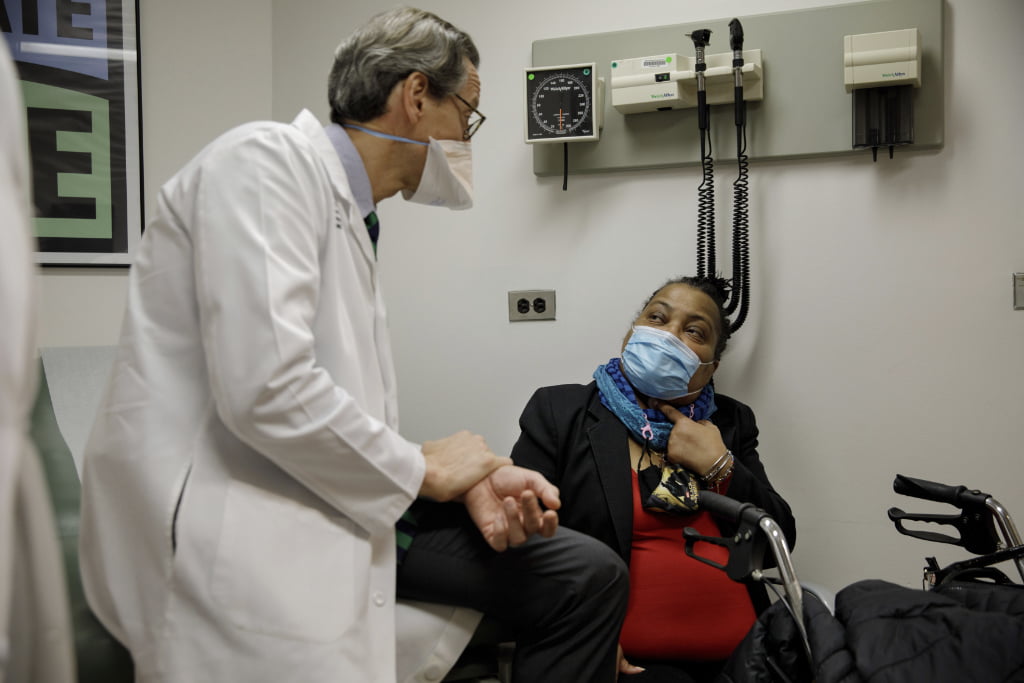
Trachea transplant recipient Sonia Sein talks with the lead surgeon of her procedure, Dr. Eric Genden, left, during a checkup visit at Mt. Sinai hospital in New York on Monday, March, 22, 2021. Sein says she had spent the last six years “trying to catch every breath at every moment” after extensive treatment for her severe asthma damaged her windpipe. But she is breathing freely again after a January windpipe transplant. (AP Photo/Marshall Ritzel)
By MARION RENAULT and MARSHALL RITZEL Associated Press
NEW YORK (AP) — Sonia Sein said she spent the last six years “trying to catch every breath at every moment” after extensive treatment for her severe asthma damaged her windpipe.
She is breathing freely again after getting an unusual transplant. In January, doctors at New York’s Mount Sinai replaced her trachea, the tube that ferries air from the mouth to the lungs.
Doctors say this drastic operation could potentially help other people including COVID-19 patients left with serious windpipe damage from breathing machines.
“We’ve talked for 100 years about just putting in a new windpipe,” said University of Washington surgeon Dr. Albert Merati, who had no role in the recent transplant.
But hooking up a trachea from a donor to a recipient’s blood supply is challenging and would only be considered as a last resort, experts say.
“It is just technically extremely difficult,” said Dr. David Klassen, chief medical officer for the United Network for Organ Sharing, or UNOS, which oversees the nation’s transplant system. “It’s been a very difficult thing to crack.”
Experts say it’s too soon to deem Sein’s transplant a total success — which UNOS said is the first of its kind in the U.S. Sein has to take powerful drugs to prevent organ rejection, but doctors hope to try to wean her off in a few years. Less than three months after the operation, there haven’t been complications or signs of rejection.
“If it was going to be a failure, we would know by now. It’s quite promising,” said Dr. Alec Patterson, a transplant surgeon at Washington University in St. Louis who was not involved in the operation. “It’s a major step forward.”
Sein’s ordeal started in 2014 when doctors put a tube in her throat to help her breathe during a severe asthma attack. It saved the 56-year-old social worker’s life but damaged her trachea.
Several surgeries to reconstruct her windpipe didn’t help and left Sein in despair at constant risk of suffocation.
Until now, doctors have had few good options to treat serious trachea damage.
The windpipe is much more than a simple tube. “Every breath we take has to be expertly conveyed from the tip of the nose to the last air sac in the lungs,” Merati said.
Over the years, various methods have been used to repair or reconstruct damaged windpipes. Doctors can remove damaged sections, or fix or replace them with prosthetics, lab-grown tissue or self-supplied tissue from a patient’s skin and rib cartilage. But these techniques may not restore full function to the organ, which uses tiny hairs to move mucus around and has the perfect flexibility to expand and collapse as we breathe, swallow and cough.
And these methods are not possible in the most dire situations where a patient’s entire windpipe is damaged. Something as extreme as a transplant could be their only hope, said Dr. Eric Genden, a Mount Sinai surgeon who led the team.
“Right now, we don’t talk much about those patients because there is no option for them,” Genden said. “We’re hoping that this procedure will … help not only the patients that are teetering on disaster, but also the patients that are currently kind of deemed hopeless.”
In an 18-hour operation, a team of more than 50 specialists transplanted a donor trachea, carefully reconnecting it to a complex web of tiny blood vessels.
“When we saw the organ come to life, we knew we had jumped the first hurdle,” said Genden said.
Doctors say the procedure could help others with tracheal birth defects, untreatable airway diseases or extensive damage from ventilators.
“This could help care for COVID-19 patients,” Merati said. “Without a doubt we are already seeing some impact” from patients being on breathing machines.
Sein is now recovering at home and “is breathing wonderfully,” Genden said.
The surgery has already allowed her to do things she couldn’t before.
“Now I feel good,” Sein said. “I dance with my granddaughter we chase each other around the house. I jump on my grandson. We play, we watch a movie together. I cook for them. We’re making the memories together.”
The Associated Press Health and Science Department receives support from the Howard Hughes Medical Institute’s Department of Science Education. The AP is solely responsible for all content.

